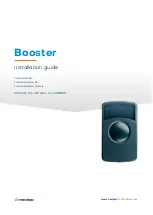feature Philips RC-5 codes. This type of IR code structure has been known to exhibit “A/B”
behavior in some products, and may be incompatible.
To be brief, these products have two different codes for each button on the remote, the “A”
version and the “B” version. The product must receive alternating (A/B/A/B, etc.) versions
of its codes or it will not respond. It doesn’t matter what code is issued (or in what order),
because the remote and the product will keep track (technically there’s more to the story,
but this is the basic principle). Since the IntelliFile II (and the IntelliControl MSU) can only
store one version of each code in memory, only the “A” or the “B” version can be learned
and stored in memory, which creates a problem.
The following procedure will help you determine if the component you are using is has
“A/B” codes:
1. Standing in front of the component, issue the “Power” command to turn it on.
This will
theoretically issue the “A” version of the “Power” command.
2. Next, completely cover the front of the remote with your hand so that the next
command you issue will be blocked.
3. With your hand covering the front of the remote, issue the “Power” command again.
This command will theoretically be the “B” version, and should not be allowed to
reach the component. The component should remain “On”.
4. Remove your hand and issue the “Power” command again.
This will once again issue
the “A” version of the code to the component.
If the component does not turn “Off”
(because it has received two “A” version codes in a row) the codes may be “A/B”.
5. Issuing the “Power” command yet again should turn the unit “Off”.
This would allow
the component to receive its “B” version “Power” command, and enable it to work
properly.
Repeat this procedure with a couple of different commands to be sure. Only allow the
product to receive every-other command
. If you are convinced the product you are using
has “A/B” codes, call Niles Technical Support at 1(800) 289-4434 for assistance.
Testing Components for Automation Conflicts
All components must be tested to ensure that their operation does not conflict with the
goal of automating the system. Try to detect IR codes that have two functions. Sometimes
this could help you automate the system (i.e. a direct IR command for a particular input
also turns the unit on. This feature is common with some Marantz and Sony receivers).
In some instances, however, they defeat automation (i.e. ADA manufactures a preamp in
which the “Mute” command mutes the preamp, but does not unmute it. A second touch of
the “Mute” key turns the preamp off).
17


















